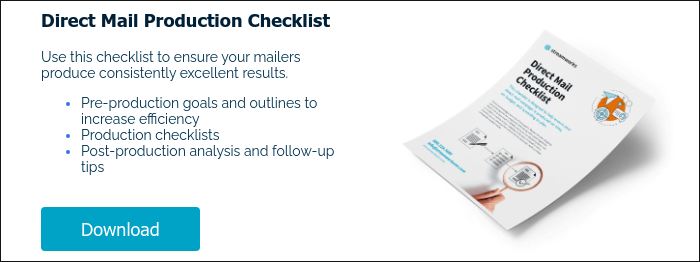Using Direct Mail Marketing for Acquisition vs. Retention
Streamworks Blog

Even in the digital age, direct mail continues to be one of the most effective marketing tactics for both new customer acquisition and retention. Contrary to popular belief, direct mail remains highly effective and relevant, producing strong measurable results for a diverse audience.
According to the 2017 DMA Response Rate Report, the household response rate for direct mail was 5.1% (compared to .6% email, .6% paid search, .2% online display, .4% social media). With numbers like that, it’s impossible to say with a straight face that direct mail has no place in your next acquisition campaign. Direct mail is also cost effective for driving leads and donor acquisition, making it a smart choice for organizations looking to maximize their marketing impact.
44% of companies put more effort into acquisition campaigns than they do retention. Why? Because many companies are concerned with increasing their market share, and perceive a wider customer base as a more lucrative customer base. Using prospect lists allows businesses to reach more customers and prospective donors, expanding their audience and improving campaign targeting. But that assumption just doesn’t hold up when you look at the data.
According to consumer research, increasing your customer retention by just 5% can increase your profits by 25-95%, and repeat online shoppers tend to spend twice as much in the third year of their relationship with a brand as they do in the first 6 months.
In a nutshell: Not only do existing customers cost less, they spend more. Which makes sense. It’s much easier to sell new products to customers who already have a relationship with your company and who trust the quality of your wares. Loyal customers are also more likely to refer new customers to your company. Investing money in targeted direct mail can yield a strong return by maintaining customer interest and encouraging referrals.
Using relevant data and customer data enables businesses to focus their efforts on the right audience, save money, and maintain customer interest, ultimately improving both acquisition and retention outcomes.
Introduction to Direct Mail
Direct mail is a time-tested marketing channel that continues to deliver impressive results, even in today’s digital-first world. At its core, direct mail involves sending physical correspondence—such as letters, brochures, or direct mail postcards—to customers and prospects with the goal of encouraging them to engage with a business. Unlike digital ads that can get lost in crowded inboxes or online feeds, direct mail stands out by providing a tangible, personal touch.
Recent research shows that direct mail campaigns often achieve a higher median return on investment (ROI) than paid search and online display ads, making them a smart addition to any marketing strategy. By incorporating direct mail into their overall marketing strategy, businesses can build trust with their target audience, foster customer retention, and reach customers in a way that feels both personal and memorable. Direct mail services make it easy for companies to create and distribute hard copy requests, ensuring their message lands directly in the hands of their audience. Whether you’re looking to connect with new prospects or strengthen relationships with existing customers, direct mail remains a powerful tool for businesses of all sizes.
Distinguishing Acquisition from Retention
It’s a mistake to overlook the importance of retention tactics, or to lump them in with acquisition campaigns. Current customers and potential customers (prospects) are completely different audiences, and should therefore receive completely different messaging. Acquisition campaigns often rely on carefully curated prospect lists to identify and target each prospect effectively.
While there’s clearly a strong case to be made for increasing your retention tactics, both acquisition and retention have a role to play in your long-term marketing strategy. Using relevant data allows marketers to focus their messaging for each audience segment, ensuring communications are tailored and more effective. Before you put together your next campaign, take a few minutes to brush up on the difference between the two tactics, and how those differences should shape your direct mail piece.
Using Direct Mail for Acquisition
By definition, the audience of an acquisition campaign is most likely not familiar with your company. That means your direct mail piece will have to concisely describe who you are and what you do in addition to making a compelling offer that will motivate recipients to engage. Acquisition campaigns are specifically designed for driving leads and donor acquisition, helping organizations grow their supporter base and reach new audiences.
An acquisition direct mail piece should seek to do the following:
-
Get prospects’ attention. Once a direct mail piece is picked up, 82% will receive at least a minute of attention, according to USPS data. Use targeted prospect lists to ensure your message reaches the right audience.
-
Introduce yourself. Concisely summarize who you are and what you offer.
-
Tell prospects what’s in it for them. A brief list of benefits or differentiators will show prospects what they stand to gain from engaging with your business, sparking interest among recipients.
-
Call them to action. According to the USPS, 79% of consumers will take immediate action from a mail piece. Make it clear what action you want them to take.
-
Convey urgency. If the recipient feels there is a limited time to take advantage of the offer, they will be more likely to act.
For instance, successful direct mail advertising strategies—such as personalized postcards, targeted offers, and creative mailers—have provided concrete examples of how businesses can acquire more customers and expand their reach.
Using Direct Mail for Retention
A direct mail campaign focused on retention is intended to strengthen the relationship you have with existing customers. This can be done by introducing them to new products, sending them exclusive offers, or suggesting relevant add-ons to products they have purchased in the past – anything that maintains a line of communication and encourages them to engage with you. As part of your retention strategy, consider sending a personalized thank you note to express appreciation and reinforce the connection with your customers.
You already have a leg up with a retention campaign because your audience is familiar with your company and is therefore more likely to stop and read your mail piece. Direct mail from a company a consumer has purchased from in the past receives a 14% higher response rate than a mailer from an unfamiliar sender.
A retention direct mail campaign that hopes to be effective should:
-
Be personal. Over 90% of respondents to a USPS survey reported that personalization—informal use of the customer’s name, location, etc.—made them more likely to open a direct mail piece. Going the extra mile with personalized messages can further enhance customer loyalty.
-
Make a relevant offer. The largest benefit of an existing customer base is that you have past purchase history information, so use it! Leverage customer data and use variable data fields to create customized offers for individual customers.
-
Make customers feel special. Including an exclusive offer or special promotion for valued customers will make them feel singled out and more likely to buy in to the offer.
A strong direct mail strategy combines acquisition and retention tactics. Tailor your campaigns to speak to their respective audiences, and your strategy will be even stronger. Providing exceptional service throughout the customer journey can further improve retention.
Measuring Success with Direct Mail
Understanding the impact of your direct mail campaigns is essential for optimizing your marketing strategy and driving business growth. According to the Data & Marketing Association (DMA), direct mail response rates are 5 to 9 times higher than those of other advertising channels, making it a standout performer in the marketing world. To accurately measure success, businesses should track key metrics such as response rates, conversion rates, and return on investment (ROI).
One effective way to monitor responses is by using unique tracking codes or personalized URLs (PURLs) on each mail piece. These tools allow businesses to attribute sales and inquiries directly to specific direct mail campaigns, providing valuable direct mail statistics for future planning. By analyzing these results, companies can identify what resonates with their audience, refine their messaging, and improve the effectiveness of future campaigns. Consistently measuring and learning from your direct mail efforts ensures that your marketing strategy remains data-driven and results-oriented.
Best Practices for Direct Mail
To get the most out of your direct mail campaigns, it’s important to follow proven best practices that maximize engagement and response rates. Start by clearly defining and segmenting your target audience—knowing who you’re reaching allows you to tailor your message for maximum relevance. Personalization is key: direct mail appeals that address the recipient by name and reference their interests or past interactions are far more likely to capture attention and drive action.
Craft your direct mail fundraising or promotional messages to be visually appealing, concise, and focused on the recipient’s needs. Set clear goals for each campaign and measure the results to understand what works best for your audience. Integrating direct mail with digital channels can also enhance the customer journey; for example, including a QR code on your mail piece can seamlessly direct recipients to a website or donation page, making it easy for them to respond. By combining these strategies, businesses can increase response rates, build stronger relationships, and ensure their direct mail campaigns deliver measurable results.
Common Mistakes to Avoid
While direct mail marketing offers many benefits, there are common pitfalls that can undermine your campaigns if not addressed. One of the biggest mistakes is failing to define your target audience, which can lead to wasted resources and low response rates. Sending generic messages that aren’t personalized to the recipient’s interests or needs can also reduce the effectiveness of your mail marketing efforts.
Another frequent error is neglecting to track response rates and campaign performance, making it difficult to measure success or identify areas for improvement. Over-mailing—sending too many mail pieces to the same audience—can cause recipients to view your messages as spam, while failing to follow up with interested prospects can result in missed sales opportunities. To avoid these issues, businesses should treat direct mail as an ongoing process, continually testing, refining, and optimizing their campaigns to better resonate with their audience and drive sales.
Integrating Direct Mail with Digital Marketing
Combining direct mail with digital marketing channels can significantly amplify the reach and effectiveness of your marketing campaigns. By integrating direct mail with email marketing, social media, and other digital platforms, businesses can create a cohesive, multi-channel marketing strategy that engages customers at every stage of their journey. Direct mail specialists can help design campaigns that seamlessly connect physical mail pieces with online experiences.
For example, including a QR code on a direct mail piece can encourage recipients to visit your website, follow your social media pages, or sign up for email updates, bridging the gap between offline and online engagement. This approach not only increases customer retention but also helps build a robust customer base and drive more sales. By incorporating direct mail into your digital marketing strategy, your business can reach customers in multiple ways, reinforce your brand message, and create a more memorable and effective marketing experience.
Looking for more ways to maximize your direct mail ROI?
Download our free Direct Mail Production Checklist to identify steps that can save time, energy and resources on your next campaign.
Editor's note: This blog was originally published July of 2017 and has been updated with fresh content.




